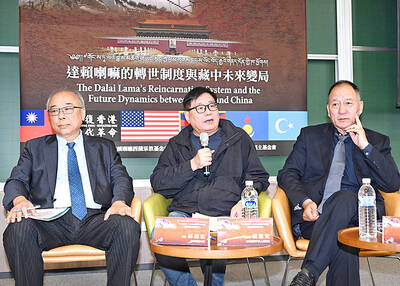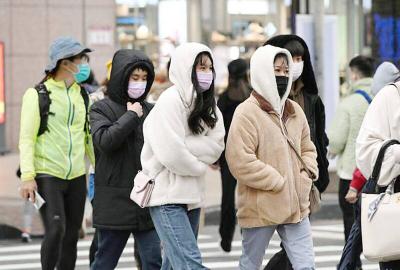Along with several other groups promoting children’s rights, the Taiwan Fund for Children and Families (TFCF) yesterday protested the downgrading of the government authority in charge of children’s affairs, urging the government to do more to protect children.
“Children’s welfare and protection is a very complicated issue that involves different government institutions — including the judicial, welfare and even economic authorities — so we would like the government to have an institution that could help integrate and coordinate efforts to protect children’s rights,” TFCF executive director Betty Ho (何素秋) told a news conference in Taipei yesterday morning. “We are quite worried that the government authorities in charge of children’s affairs are not high enough in the administrative hierarchy to handle everything.”
Ho was referring to the dissolution of the former Children’s Welfare Bureau under the Ministry of the Interior in June as part of the latest administrative restructuring. Matters originally handled by the bureau are now shared among various subdivisions of the Ministry of Health and Welfare.
Ho said the nation’s birth rate is now the lowest in the world, but the incidence of child abuse has reached a record high in the past two years, with about 20,000 children abused every year.
The Bureau of Children’s Welfare was a specialized, third-level central government bureau. However, authorities now handling child protection matters are below the third level and are not specialized organizations.
TFCF social resources director Liu Hsiu-feng (林秀鳳) agreed.
“People nowadays are having fewer children, the population is aging and the average salary is on the decline,” Lin said. “If we don’t put more effort into helping children and juveniles now, the future of our society is quite worrisome.”
The groups said that in many European countries, such as the UK, Germany, France and Sweden, children’s affairs are handled by second-level administrative organizations, while in the US, Japan, South Korea and Singapore, third-level government authorities are in charge.
“We should not fall behind these countries,” a TFCF press statement said.
Since July, as many as 360,000 people — including government officials and business leaders — have signed a petition to support the TFCF’s call.
The Control Yuan issued corrective measures to both the central and local governments in June in response to poor coordination among agencies in dealing with cases of abuse, saying there is an urgent need to improve both vertical and horizontal communication and to establish a committee under the Cabinet, Ho said.
“The children and youth rights promotion committee could act as a platform for facilitating communication between different government agencies,” National Taiwan University social work professor Cheng Li-chen (鄭麗珍) said.
“It would be a mistake to assume that a low birth rate has rendered the concentration of resources for children’s welfare unnecessary. On the contrary, building a children-friendly environment would encourage more people to have babies,” Cheng said.

ALIGNED THINKING: Taiwan and Japan have a mutual interest in trade, culture and engineering, and can work together for stability, Cho Jung-tai said Taiwan and Japan are two like-minded countries willing to work together to form a “safety barrier” in the Indo-Pacific region, Premier Cho Jung-tai (卓榮泰) yesterday said at the opening ceremony of the 35th Taiwan-Japan Modern Engineering and Technology Symposium in Taipei. Taiwan and Japan are close geographically and closer emotionally, he added. Citing the overflowing of a barrier lake in the Mataian River (馬太鞍溪) in September, Cho said the submersible water level sensors given by Japan during the disaster helped Taiwan monitor the lake’s water levels more accurately. Japan also provided a lot of vaccines early in the outbreak of the COVID-19 pandemic,

Kaohsiung Mayor Chen Chi-mai (陳其邁) on Monday announced light shows and themed traffic lights to welcome fans of South Korean pop group Twice to the port city. The group is to play Kaohsiung on Saturday as part of its “This Is For” world tour. It would be the group’s first performance in Taiwan since its debut 10 years ago. The all-female group consists of five South Koreans, three Japanese and Tainan’s Chou Tzu-yu (周子瑜), the first Taiwan-born and raised member of a South Korean girl group. To promote the group’s arrival, the city has been holding a series of events, including a pop-up

TEMPORAL/SPIRITUAL: Beijing’s claim that the next Buddhist leader must come from China is a heavy-handed political maneuver that will fall flat-faced, experts said China’s requirement that the Dalai Lama’s reincarnation to be born in China and approved by Beijing has drawn criticism, with experts at a forum in Taipei yesterday saying that if Beijing were to put forth its own Dalai Lama, the person would not be recognized by the Tibetan Buddhist community. The experts made a remarks at the two-day forum hosted by the Tibet Religious Foundation of His Holiness the Dalai Lama titled: “The Snow Land Forum: Finding Common Ground on Tibet.” China says it has the right to determine the Dalai Lama’s reincarnation, as it claims sovereignty over Tibet since ancient times,

Temperatures in some parts of Taiwan are expected to fall sharply to lows of 15°C later this week as seasonal northeasterly winds strengthen, the Central Weather Administration (CWA) said today. It is to be the strongest cold wave to affect northern Taiwan this autumn, while Chiayi County in the southwest and some parts of central Taiwan are likely to also see lower temperatures due to radiational cooling, which occurs under conditions of clear skies, light winds and dry weather, the CWA said. Across Taiwan, temperatures are to fall gradually this week, dropping to 15°C to 16°C in the early hours of Wednesday